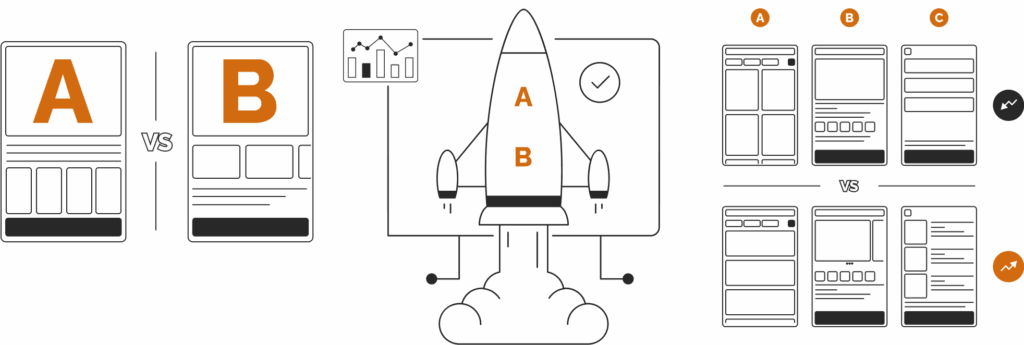Experts in
Experimentation
Unlock higher conversions and make smarter decisions through continual website experimentation and testing

We decided to switch our experimentation agency to 120Feet because we wanted a flexible contract that allowed us scale and grow when it best suits Domino’s without the complication of rigid and expensive long-term retainers.
Their service has been fantastic – with proactive advice and guidance, and the delivery of great experiments.
They do all the heavy lifting which allows me to focus on the bigger picture items, such as taking action based on 120Feet’s analysis and recommendations.
I only wish we’d made the switch sooner.

Experimentation Owner
Domino’s

Experimentation
Website experimentation involves systematically testing different variations of a website’s elements to determine which version performs better in achieving specific objectives; such as improving user engagement, increasing conversion rates or enhancing overall user experience.
This process often utilises A/B testing (comparing two versions) or multivariate testing (testing multiple variables simultaneously) to gather data-driven insights.
By experimenting with different page layouts and journeys, organisations can make informed decisions based on actual user behaviour rather than assumptions and guesses.
This approach allows for continuous optimisation of a website, ensuring it meets the users’ needs whilst effectively maximising the site’s effectiveness in achieving its business goals, usually conversions and profits.
All experimentation and testing tools are broadly trying to achieve the same end goal but they get there in a slightly different manner and at significantly different price points.
120Feet can support all tools, and right now we’re finding the most popular to be Adobe Target and Monetate.
6 great experimentation Use-Cases

Improving goal conversions
Experimenting with different elements of a webpage, such as the call-to-action (CTA) buttons, forms and landing page layouts in order to see which variations lead to higher conversion rates.
This could involve testing different colours, positioning, messaging or designs of CTA buttons to determine which version best encourages more users to reach the desired goal. Be it making a purchase, signing up for a newsletter or registering for a service for example.

Enhancing user engagement
Testing different content formats, navigation structures, and interactive elements to identify what keeps users engaged longer on the site.
This might include experimenting with video content versus text, different arrangements of menu items or varying the layout of articles and product pages to see what leads to increased time spent on the site and more page views per visit.

Optimising landing pages
Focusing on landing pages to test various headlines, images, page layouts and content lengths to find the most effective combination that drives the desired user action.
This is crucial for marketing campaigns where the goal is to maximise the impact of first impressions and encourage immediate engagement from potential customers.

Personalisation and targeting
Experimenting with personalised content and targeted messages based on user behaviour, demographics or location to improve relevance and effectiveness.
This can involve showing different offers to new visitors versus returning customers or customising content for users from different regions in order to increase the likelihood of a conversion or goal.

Testing checkout processes
Streamlining and optimising the checkout process to reduce cart abandonment rates. This includes experimenting with the number of steps in the checkout process, the information required from the user, the presentation of shipping options and costs and the visibility of security badges or return policies.
The goal is to make the checkout as smooth and reassuring for the user as possible, thereby increasing the completion rate of purchases.

Fixing site issues
Not all site issues can be quickly fixed by a website’s developer and as a stop-gap often the experimentation tool can be used to replace out of date, incorrect or broken site content.
We only recommend this approach as a temporary fix until a client developer can properly address the issue.
Ready to crush your next big challenge? Let’s talk strategy - your win starts here!

Getting started with, or improving, your experimentation program
120Feet is a full-stack experimentation provider, supporting all areas from ideation through to technical build, QA, statistical analysis and recommendations.
Organisations just getting started with experimentation may need help with all tasks. Whilst those with an established programme may only need support with technical build and QA in order to ease the most common bottleneck and blocker which is limiting their experiment run rate.
Key steps to deliver an effective experimentation programme:
- Embed a testing culture within the business, so relevant departments understand why testing is important and how it is creative value.
- Create and manage a testing roadmap to ensure you hit your monthly / annual experiment run-rate target.
- Set up processes, create relevant documentation and templates. Having a logical and proven framework is essential to deliver a well-thought-out and effective experimentation programme.
- Discovery, ideation and strategy sessions to gather and develop experimentation ideas. Initially, we’d expect to have a few workshops to hear your experimentation ideas and provide several of our own, and we can supplement this list with analytics insights to identify site conversion issues and opportunities.
- Experimentation briefs: scope out, research, prioritise, groom and estimate experiments. Create a test plan and experiment briefs for stakeholder approvals.
- Technical build and development: build experiments in your tool of choice and solutions to support test ideas.
- QA for the most common devices, operating systems and browsers. Typically, aided by the use of tools such as Browserstack.
- Launch and monitor experiments. Provide in-flight analysis and reports in-line with your statistical methodology. Analyse experiments in a range of different statistical methods. Communicate experiment results and recommendations to your stakeholders to maximise buy-in and develop your experimentation culture.
- Liaise with developers and stakeholders so the site is updated to adapt the winning experiments and become the default way the site should work.
- Over time move to a continuous discovery process.
Contact us
Send us a message with your details and we’ll get right back to you